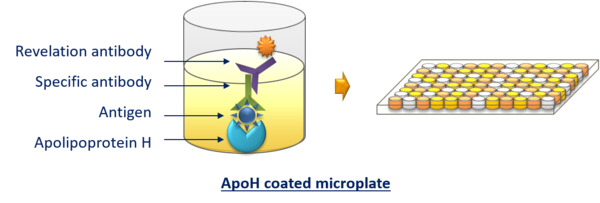ELISA plates
ApoH protein is coupled onto 96-well plates that allow the detection of micro-organisms present in a sample, using the same principle as an ELISA test.
A biological sample likely to contain infectious agents (viruses, bacteria...) is loaded in an ApoH-plate well. After incubation, the supernatant is removed while the antigens are bound to the ApoH protein at the bottom of the well. After binding, the wells are then washed and loaded with a primary antibody specific to the targeted antigen. A labeled secondary antibody is then added for the revelation.
These ApoH plates offer an efficient and low-cost alternative to ELISA tests based only on antibodies. The key features are:
• speed of development: new pathogenic agents are immediately recognized by the ApoH protein, whereas the development of specific antibodies can take several months;
• binding efficacy: thanks to its wide specificity, the ApoH protein also interacts with infectious agents of high antigenic variability such as HIV or Hepatitis C viruses;
• cost reduction: ApoH can valuably replace a wide range of antibodies in multiplexing assays.
The needed specificity is ensured by using revelation antibodies specific to the targeted antigen.
